Poor Posture Ruins Your Body—Fix It With 15 Easy Exercises
Most of us spend the majority of the day twisted into some sort of contortion in front of a computer screen, looking down at our phone or curled up on the couch. The hunched back, the rounded shoulders, the neck tilt — just how bad is poor posture for our body?
According to experts, it's pretty bad.
What is “posture” exactly?
Our posture is how we hold our body in space and there are two types. Static posture is how one positions and holds their body when not moving, such as when they are sleeping or sitting. Dynamic posture is how one positions and holds their body when they are moving, such as when they are walking or running.
Most commonly, it is referring to how we hold our body in an upright or weight-bearing posture. When we have a good upright posture, we are using our muscles well and holding our bodies up biomechanically in an optimal way so that all of our associated systems can work well together.
What is good posture?
The difference between good and bad posture comes down to spine alignment. When someone has good posture, they are maintaining the "normal" alignment of their spine. The spine has three main curves to the cervical spine (or neck), thoracic spine (or mid back) and lumbar spine (or low back). The thoracic spine has a 'C' shaped curve. In contrast, the neck and low back have a backwards 'C' shaped curve. So, good posture is when someone exhibits the normal amount of curvature in the spine, whereas bad posture is when someone exhibits too much or too little curvature in the spine.
Advantages of good posture
Maintaining good posture is important because it promotes balance to the muscles, tendons and ligaments, and also ensures optimal alignment of the bones and joints. For example, consider someone working at a computer. Regardless of how much motion they exhibit at the different levels of the spine, they need the same amount of total motion to sit and type. So, if they are sitting hunched, such that the low back is bent too far forward, the mid-back and neck may have to compensate by bending too far backward. This results in improper bone and joint alignment, and excessive strain to various muscles, tendons and ligaments.
Well that explains the searing pain radiating down my neck. But are these minor (albeit uncomfortable) aches and pains the only consequence of my poor posture? Or is there more at stake?
Maintaining a good posture is important as it puts us in the best position to mechanically perform any activities and offset any stresses in the system. When we have bad posture, we can reduce the function of our other organ systems, like the cardiovascular, respiratory, digestive and psychological systems such that they can cause problems in those specific systems.
In fact, pain and discomfort are just the tip of the iceberg — over time, this stress on the body can lead to some pretty serious issues.
Bad posture, over time, can result in poor alignment of bones and joints, and strain to muscles, tendons and ligaments. If the joints are in poor alignment, it may result in not only wear and tear to the joint itself, but also weakness, fatigue and inefficiency of the muscles. Essentially, poor posture over time can result in breakdown of your body, leading to a poor quality of life.
It can also cause issues with blood pressure, breathing, metabolism, digestion, lead to chronic conditions and cause pain. It can affect your mood and psychological state in a detrimental way.
How can I tell if I have good posture?
OK, so we know that good posture is important to keep our body functioning in a healthy way, but can you tell if you have it?
The simplest thing people can do is to listen to their body. If you have aches and pains in your back, or discomfort with maintaining positions for a long period of time, that may be an indication of a bad posture. Another sign of bad posture is if you feel that there is an uneven distribution of your weight between the left and right side of your body. Always remind yourself that whether sitting or standing, your weight should be evenly distributed, your shoulders should be back, and all three curves of your spine should be present.
If you are experiencing some of these symptoms, seeing a physical therapist for an assessment may help.
We teach our clients to be aware of what they feel in their bodies and then to see if they can change their posture in space. We take the time to educate them on what it looks and feels like to have good and bad posture so that they can correct on their own.
How to correct poor posture
If, like me, you are feeling the effects of poor posture, there are things you can do at home to correct course. Starting with these two things to improve posture:
Listen to your body. Be aware so that you remember to maintain good posture when standing, sitting, driving, lifting and sleeping.
Exercise. Strengthening your core and stretching the body is key. Five exercises that can help improve your posture are child’s pose, cobra pose, pigeon pose, thoracic rotation and planks.
Posture Exercises
Improving your posture is about opening up the front of the body, while strengthening the back. Learn how to perform specific exercises that can help strengthen weak muscles and stretch the tight ones responsible for poor posture.
 Cow Face Pose
In a seated or standing position, raise your right arm up to the ceiling. Bend the right elbow, reaching your hand down the back of your neck. Now, bring your left arm to wrap around your left side and reach up toward your right hand. Shift your arm up the midline of your back to clasp your hands behind your back. If you cannot reach, simply reach the fingertips toward each other as closely as possible. Breathe deep and evenly, holding for as long as you wish before switching sides to repeat.
Cow Face Pose
In a seated or standing position, raise your right arm up to the ceiling. Bend the right elbow, reaching your hand down the back of your neck. Now, bring your left arm to wrap around your left side and reach up toward your right hand. Shift your arm up the midline of your back to clasp your hands behind your back. If you cannot reach, simply reach the fingertips toward each other as closely as possible. Breathe deep and evenly, holding for as long as you wish before switching sides to repeat.
 Reverse Table Top
Start sitting down, and place your hands behind your back with your fingertips reaching toward your butt. Place your palms flat on the ground, and walk your feet forward. Press down through the feet and the palms to lift your butt up off of the ground. Engage your core to straighten your back from your neck to your knees. Bring your shoulders over your wrists, and your knees over your ankles, and hold this pose for a few breaths. Then release. Repeat 3 times.
Reverse Table Top
Start sitting down, and place your hands behind your back with your fingertips reaching toward your butt. Place your palms flat on the ground, and walk your feet forward. Press down through the feet and the palms to lift your butt up off of the ground. Engage your core to straighten your back from your neck to your knees. Bring your shoulders over your wrists, and your knees over your ankles, and hold this pose for a few breaths. Then release. Repeat 3 times.
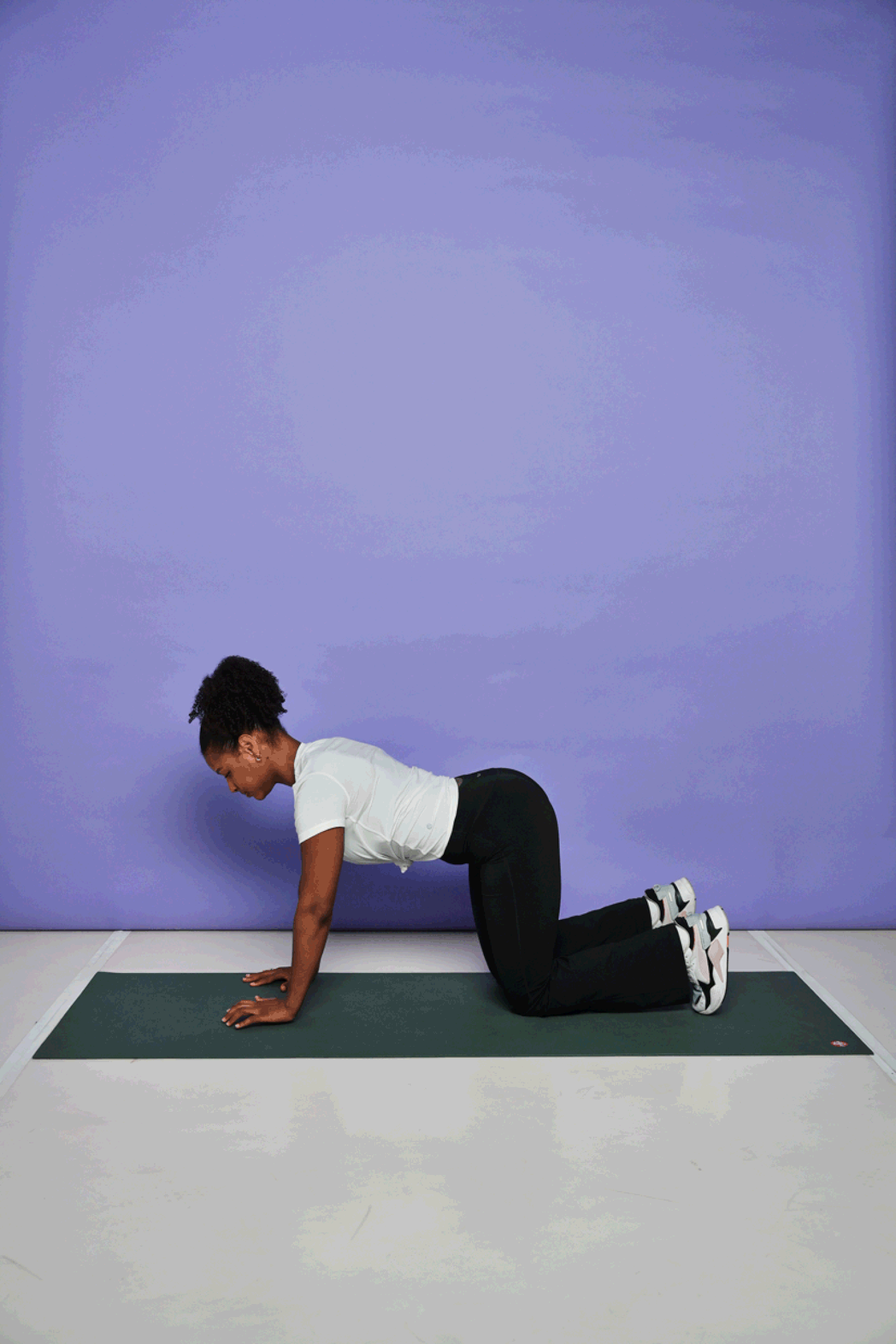 Bird Dog
Start on all fours with your shoulder over your wrists and hips stacked above the knees. Straighten your left arm out in front of you and your right leg out behind you, balancing on your opposite hand and knee. Hold for a few breaths. For an added challenge, bend your left elbow and your right knee in toward each other until they touch underneath your stomach. Switch sides and repeat using your right arm and left leg. Continue alternating, performing 10 reps on each side.
Bird Dog
Start on all fours with your shoulder over your wrists and hips stacked above the knees. Straighten your left arm out in front of you and your right leg out behind you, balancing on your opposite hand and knee. Hold for a few breaths. For an added challenge, bend your left elbow and your right knee in toward each other until they touch underneath your stomach. Switch sides and repeat using your right arm and left leg. Continue alternating, performing 10 reps on each side.
 Child’s Pose
Kneel on the floor so that your shins and the tops of your feet are on the ground. Bend at your hips, moving your hands forward and your butt back. Inch your hands out in front of you until your stomach is resting on your thighs and your arms are stretched straight out in front of you, palms on the floor. Focus on your breathing, and take it slow.
Child’s Pose
Kneel on the floor so that your shins and the tops of your feet are on the ground. Bend at your hips, moving your hands forward and your butt back. Inch your hands out in front of you until your stomach is resting on your thighs and your arms are stretched straight out in front of you, palms on the floor. Focus on your breathing, and take it slow.
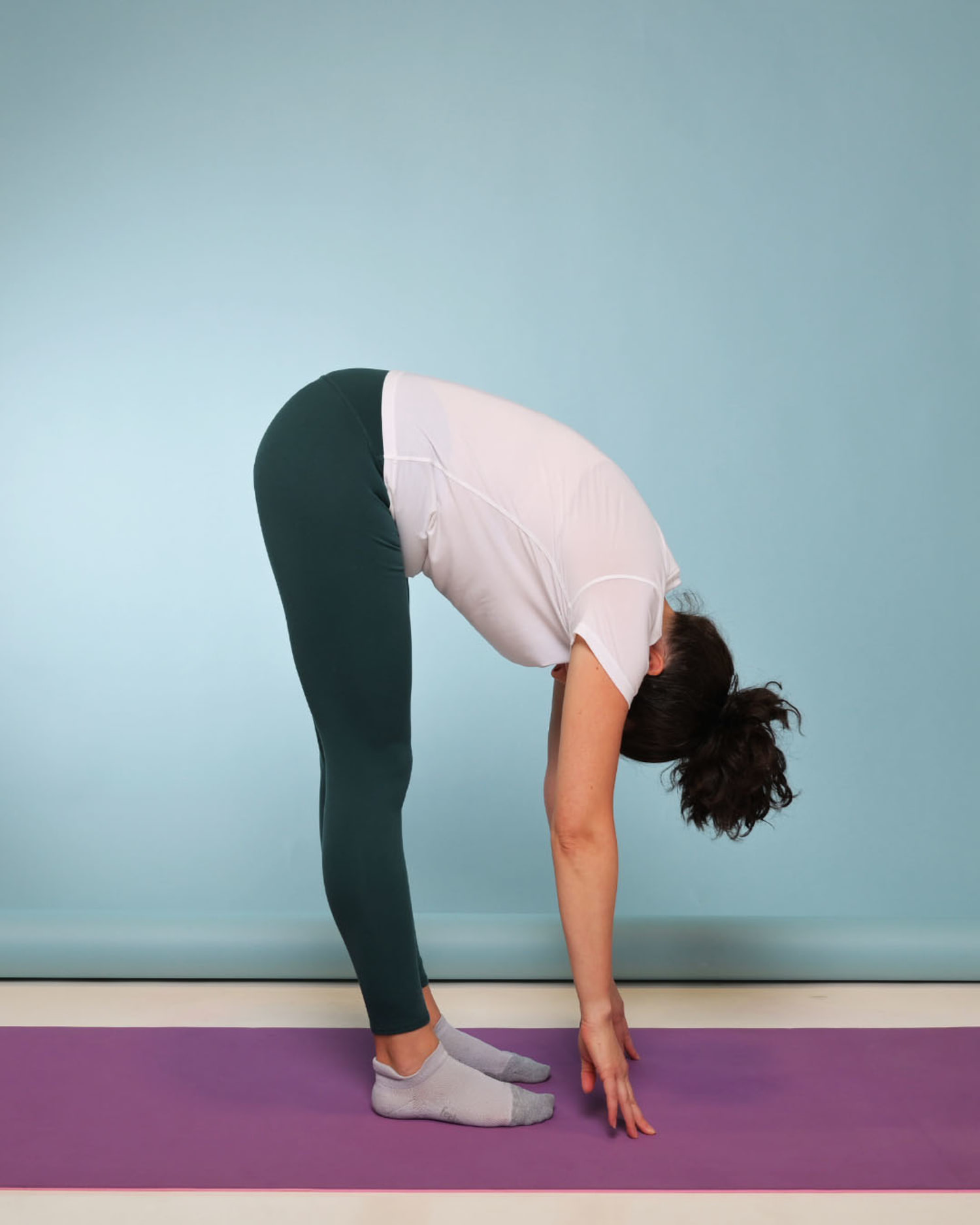 Forward Fold
If you have a hard time reaching toward your toes in a seated forward fold, performing the move standing allows gravity to help you get deeper into the stretch. Start standing with feet hips-width apart. Bend at the waist, reaching your hands toward the ground and letting your head hang between your arms. Hold here for 10-20 seconds, letting yourself sink deeper with each breath.
Forward Fold
If you have a hard time reaching toward your toes in a seated forward fold, performing the move standing allows gravity to help you get deeper into the stretch. Start standing with feet hips-width apart. Bend at the waist, reaching your hands toward the ground and letting your head hang between your arms. Hold here for 10-20 seconds, letting yourself sink deeper with each breath.
 Plank
Place your hands and knees on a mat, lining up your shoulders over your wrists, with your wrists parallel with the front of the mat. Make sure that your shoulders stay over your wrists, so your hips will not be over your knees anymore; your hips will be further forward, and your knees will be behind your hips. Engage the abs. Pretend there is fire on the mat and you need to pull your stomach away from the fire. Lift your legs up off of the ground and squeeze your quads, reaching your heels toward the back of the room. Keep your head and neck elongated, and if you have a mirror, check yourself out to ensure that you’re in one straight line.
Plank
Place your hands and knees on a mat, lining up your shoulders over your wrists, with your wrists parallel with the front of the mat. Make sure that your shoulders stay over your wrists, so your hips will not be over your knees anymore; your hips will be further forward, and your knees will be behind your hips. Engage the abs. Pretend there is fire on the mat and you need to pull your stomach away from the fire. Lift your legs up off of the ground and squeeze your quads, reaching your heels toward the back of the room. Keep your head and neck elongated, and if you have a mirror, check yourself out to ensure that you’re in one straight line.
 Chest Stretch
Stand tall with your feet hips-width apart and place your hands behind your back, interlocking your fingers. Straighten your arms down toward the ground and try to bring the palms together, bringing your shoulder blades toward each other until you feel a pull in your chest. Hold for a few breaths and then release.
Chest Stretch
Stand tall with your feet hips-width apart and place your hands behind your back, interlocking your fingers. Straighten your arms down toward the ground and try to bring the palms together, bringing your shoulder blades toward each other until you feel a pull in your chest. Hold for a few breaths and then release.
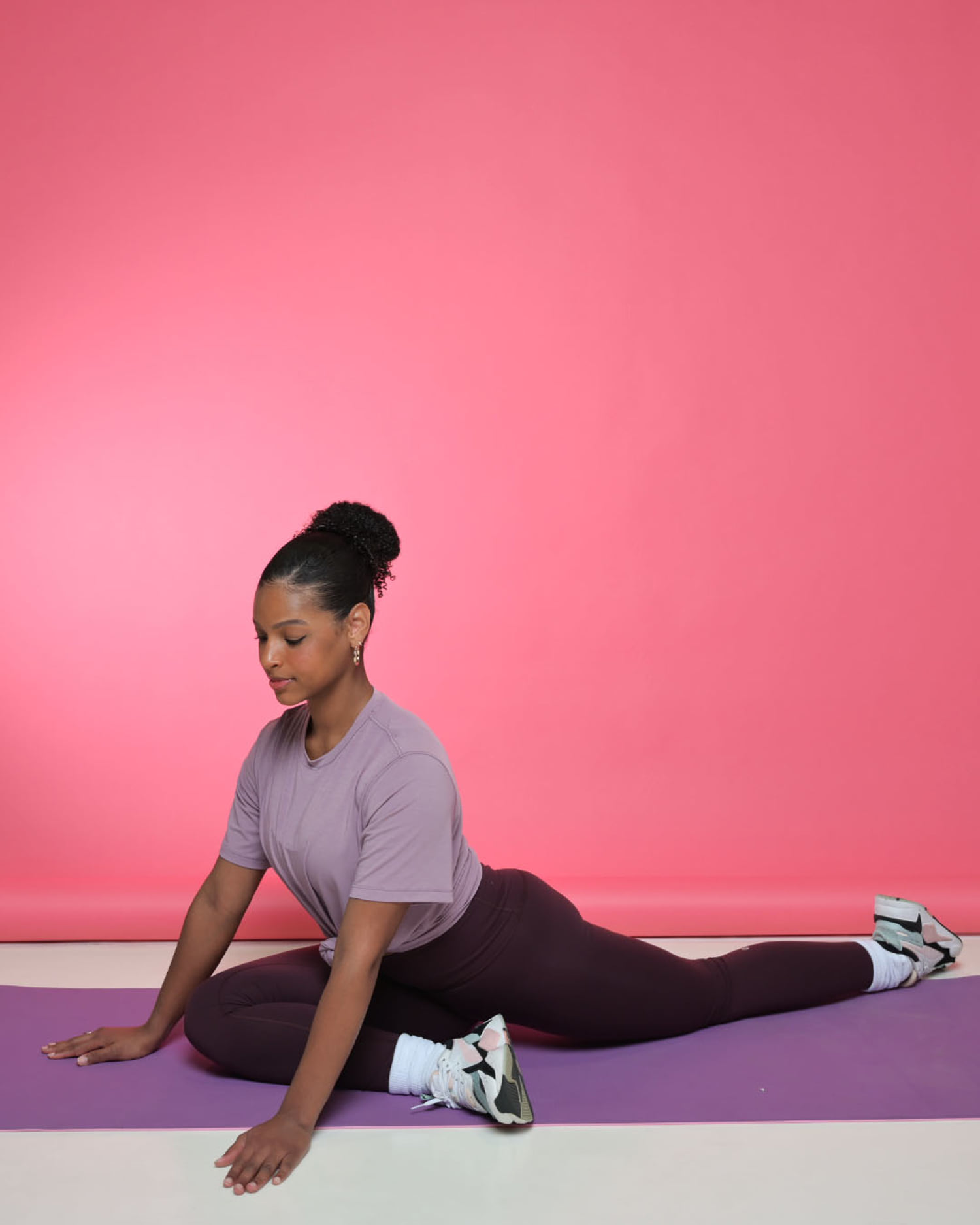 Pigeon
Start in a downward facing dog. Bring the right leg forward toward your right hand and rest it on the mat, while reaching your right ankle toward the left hand and resting it on the mat (as close to your hand as is comfortable for you.) Ideally, your right shin will be parallel to the front of the mat. Lower your hips toward the floor, resting on top of your right leg. Straighten your left leg out behind you. Keep your hips square, balancing your weight by pressing your hands down onto the mat in front of you. If this is enough of a stretch, stay here and breathe. If you want a deeper stretch, bend at the hips, bringing your torso down toward the mat and reaching over your bent front leg. Flex your right foot. Maintain this position for 60 seconds; breathe slowly.
Pigeon
Start in a downward facing dog. Bring the right leg forward toward your right hand and rest it on the mat, while reaching your right ankle toward the left hand and resting it on the mat (as close to your hand as is comfortable for you.) Ideally, your right shin will be parallel to the front of the mat. Lower your hips toward the floor, resting on top of your right leg. Straighten your left leg out behind you. Keep your hips square, balancing your weight by pressing your hands down onto the mat in front of you. If this is enough of a stretch, stay here and breathe. If you want a deeper stretch, bend at the hips, bringing your torso down toward the mat and reaching over your bent front leg. Flex your right foot. Maintain this position for 60 seconds; breathe slowly.
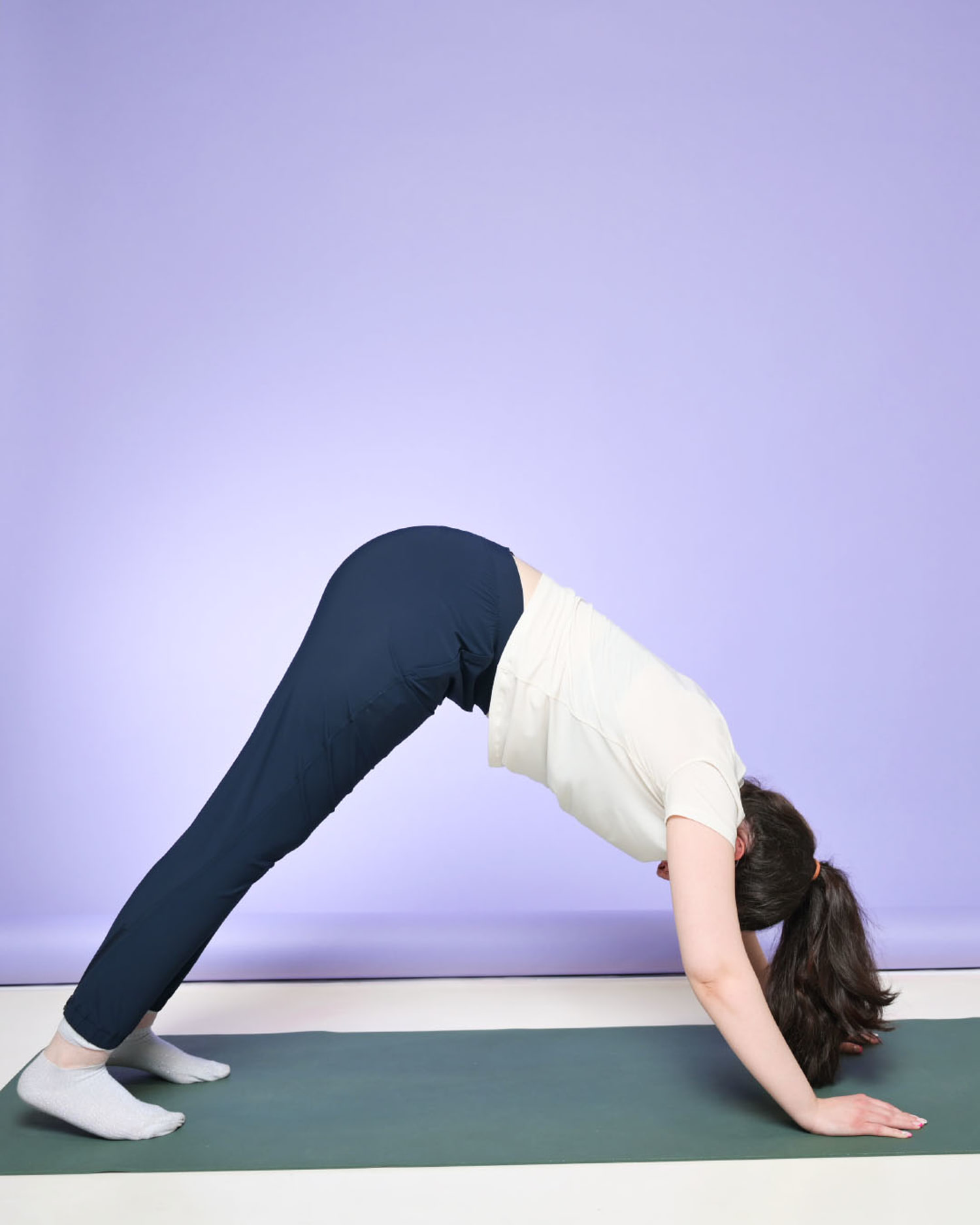 Downward Dog
Begin in plank position with your body in a straight line. Keep your arms straight with your palms pressing down on the mat. With your knees slightly bent, tuck in your belly and think about pulling your chest toward your thighs while lifting your butt up toward the sky. Once you are lifted into the final position, straighten your legs gently. Keep your head between your upper arms and relax your shoulders. Reach your legs long so that your heels touch the ground. If this isn’t possible, focus on lengthening your spine rather than forcing the feet to be flat on the ground.
Downward Dog
Begin in plank position with your body in a straight line. Keep your arms straight with your palms pressing down on the mat. With your knees slightly bent, tuck in your belly and think about pulling your chest toward your thighs while lifting your butt up toward the sky. Once you are lifted into the final position, straighten your legs gently. Keep your head between your upper arms and relax your shoulders. Reach your legs long so that your heels touch the ground. If this isn’t possible, focus on lengthening your spine rather than forcing the feet to be flat on the ground.
 Reverse Prayer Stretch
Standing or sitting, reach your hands behind your back. Reach your fingertips toward each other in the middle back, and bring your shoulders back. If that feels easy, you can make a fist with your hands and press them together. Or, to go even further, you can press your palms together in a prayer position. Hold for 2-4 breaths, then release.
Reverse Prayer Stretch
Standing or sitting, reach your hands behind your back. Reach your fingertips toward each other in the middle back, and bring your shoulders back. If that feels easy, you can make a fist with your hands and press them together. Or, to go even further, you can press your palms together in a prayer position. Hold for 2-4 breaths, then release.
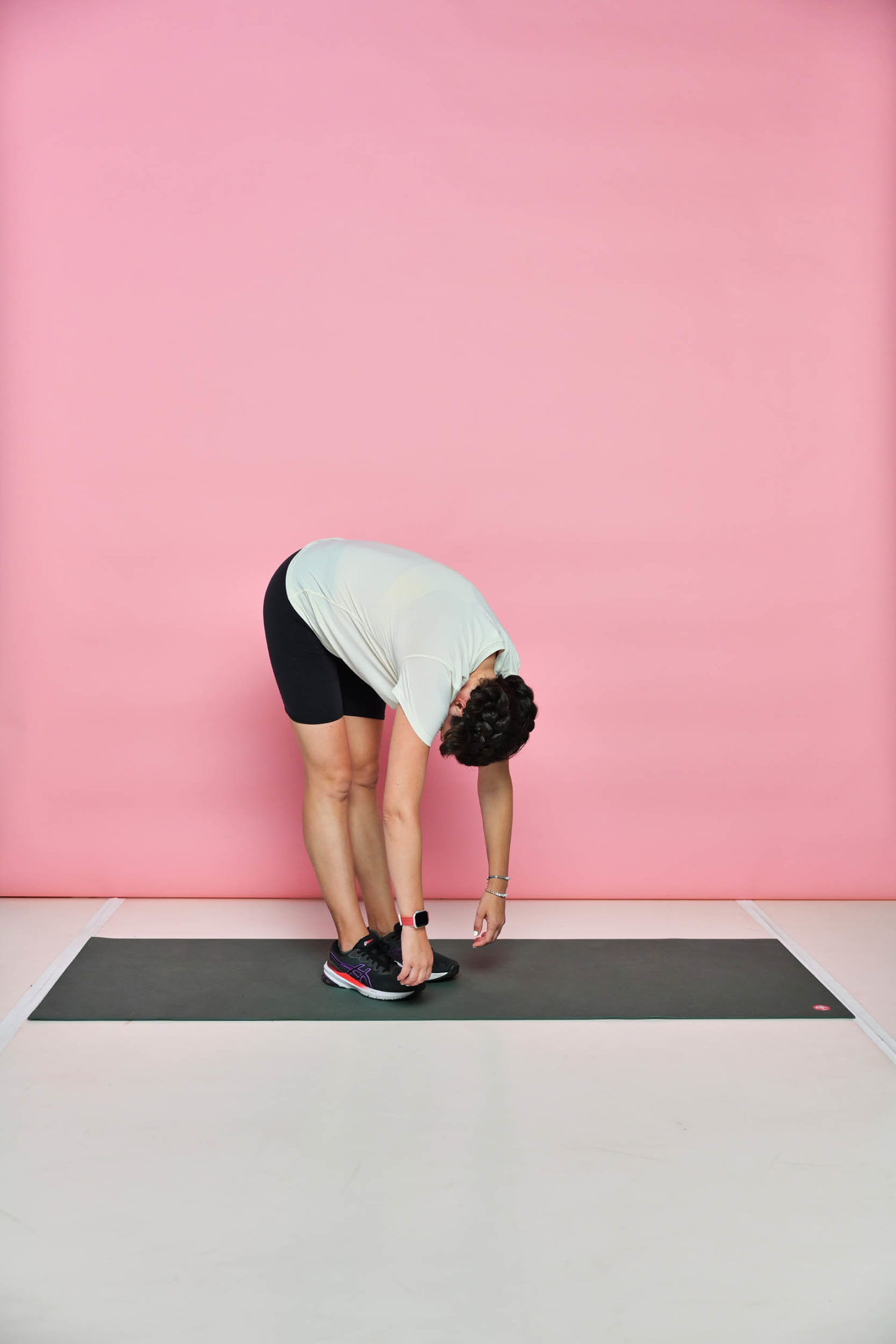 Ragdoll
Stand with feet hip-width apart. Add a slight bend to your knees. Exhale as you fold at the hips, allowing your torso to fall forward. You can let your arms hang or grasp opposite elbows as you shift your weight forward. Sway side to side letting your neck hang loose. Perform for as long as desired, starting with 15 seconds.
Ragdoll
Stand with feet hip-width apart. Add a slight bend to your knees. Exhale as you fold at the hips, allowing your torso to fall forward. You can let your arms hang or grasp opposite elbows as you shift your weight forward. Sway side to side letting your neck hang loose. Perform for as long as desired, starting with 15 seconds.
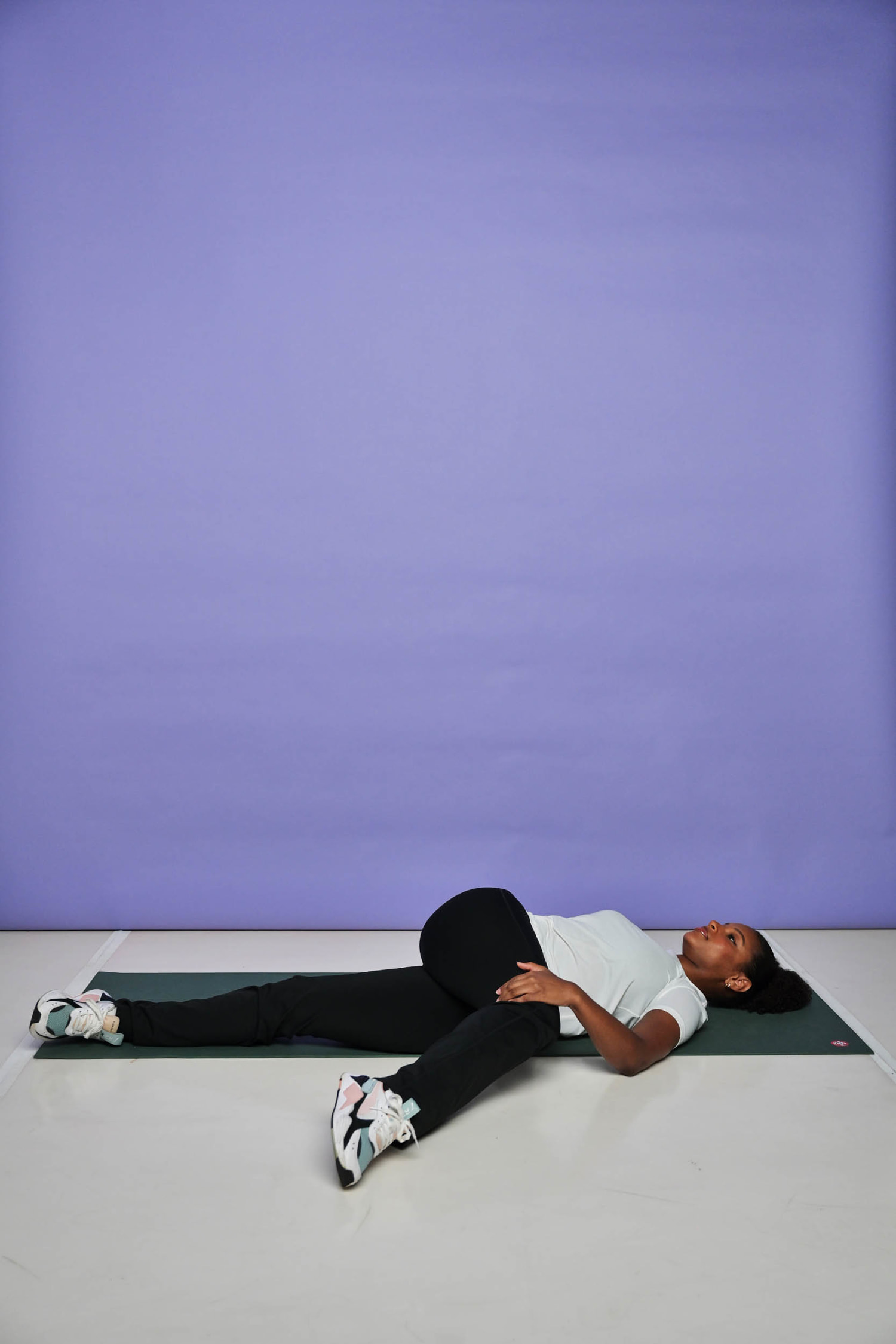 Supine Twist
Lie down on your back, legs extended. Pull your right knee up to your chest. Allow your right knee to fall across your body to touch the floor. Keep your left leg straight on the floor. Extend your right arm out to the side. Use your left hand to press your knee down to the floor to obtain a deeper stretch. Hold for about 30 seconds. Repeat on the other side.
Supine Twist
Lie down on your back, legs extended. Pull your right knee up to your chest. Allow your right knee to fall across your body to touch the floor. Keep your left leg straight on the floor. Extend your right arm out to the side. Use your left hand to press your knee down to the floor to obtain a deeper stretch. Hold for about 30 seconds. Repeat on the other side.
 Bent Over Row
Step on the resistance band with both feet hip-width distance apart. Grab one handle of the resistance band in each hand, palms facing each other. Add a slight bend in your knees, pushing your hips back to hinge forward at the torso. Maintain a flat back with core engaged. Let your arms hang straight down under your shoulders, adding a slight bend to your elbows. Drive your elbows straight up to bring the resistance band to your chest, keeping elbows tucked into your sides. Slowly lower back to the starting position. Repeat for 10 repetitions.
Bent Over Row
Step on the resistance band with both feet hip-width distance apart. Grab one handle of the resistance band in each hand, palms facing each other. Add a slight bend in your knees, pushing your hips back to hinge forward at the torso. Maintain a flat back with core engaged. Let your arms hang straight down under your shoulders, adding a slight bend to your elbows. Drive your elbows straight up to bring the resistance band to your chest, keeping elbows tucked into your sides. Slowly lower back to the starting position. Repeat for 10 repetitions.
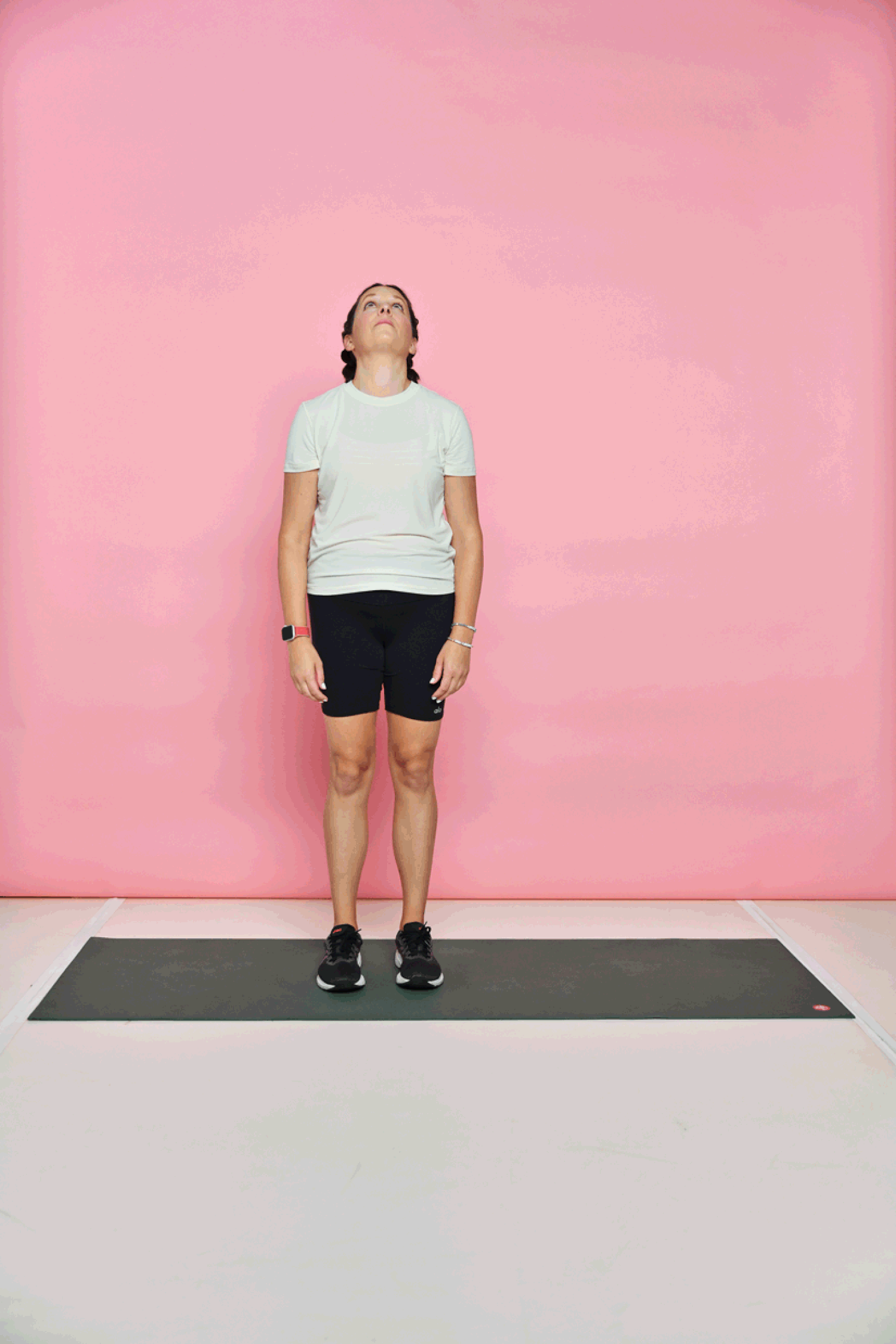 “Yes” and “no” stretch
Standing tall with your arms at your sides and shoulders relaxed, nod your head up and down like you are motioning “yes.” Drop your chin toward your chest as far as you can. Then, lift your head up toward the ceiling. Repeat 10 times.
“Yes” and “no” stretch
Standing tall with your arms at your sides and shoulders relaxed, nod your head up and down like you are motioning “yes.” Drop your chin toward your chest as far as you can. Then, lift your head up toward the ceiling. Repeat 10 times.
 After saying “yes,” it’s time to say “no.” With your back straight, arms at your sides and shoulders relaxed, look toward your right as far as you can. Then slowly move your head to the left as far as you can. Keep your shoulders back and avoid jutting your chin forward. Repeat 10 times.
After saying “yes,” it’s time to say “no.” With your back straight, arms at your sides and shoulders relaxed, look toward your right as far as you can. Then slowly move your head to the left as far as you can. Keep your shoulders back and avoid jutting your chin forward. Repeat 10 times.



